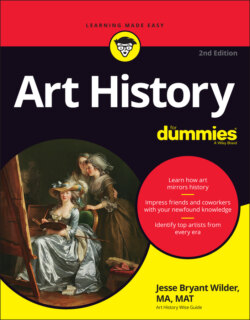Читать книгу Art History For Dummies - Jesse Bryant Wilder - Страница 11
Art Tour through the Ages
ОглавлениеIN THIS CHAPTER
Understanding the difference between art history and plain, old history
Recognizing the importance of art from prehistoric times to the present
Seeing how art periods are linked to environment and culture
Identifying the various art historical periods
Noting the effects of modern pressures on art development
Why study art history rather than music history, literary history, or the history of the postage stamp? Art history, which begins around 30,000 BC with the earliest known cave paintings (see Chapter 4), predates writing by about 26,500 years! That makes art history even older than history, which begins with the birth of script around 3500 BC. Along with archaeology, art history is one of our primary windows into prehistory (everything before 3500 BC). Cave paintings, prehistoric sculpture, and architecture together paint a vivid — although incomplete — picture of Stone Age and Bronze Age life. Without art history, we would know a lot less about our early ancestors.
Okay, but what do you need art history for after people learned to write during the historical period, which kicks in around 3500 BC? History is the diary of the past — ancient and relatively recent peoples writing about themselves combined with our interpretations of what they say. Art history is the mirror of the past. It shows us who we were, instead of telling us, as history does. Just as home movies document a family’s history (what you wore when you were five, how you laughed, and what you got for your birthday), art history is the “home movie” of the entire human family through the ages.
History is the study of wars and conquests, mass migrations, and political and social experiments. Art history is a portrait of humankind’s inner life: people’s aspirations and inspirations, hopes and fears, spirituality, and sense of self throughout the ages.
